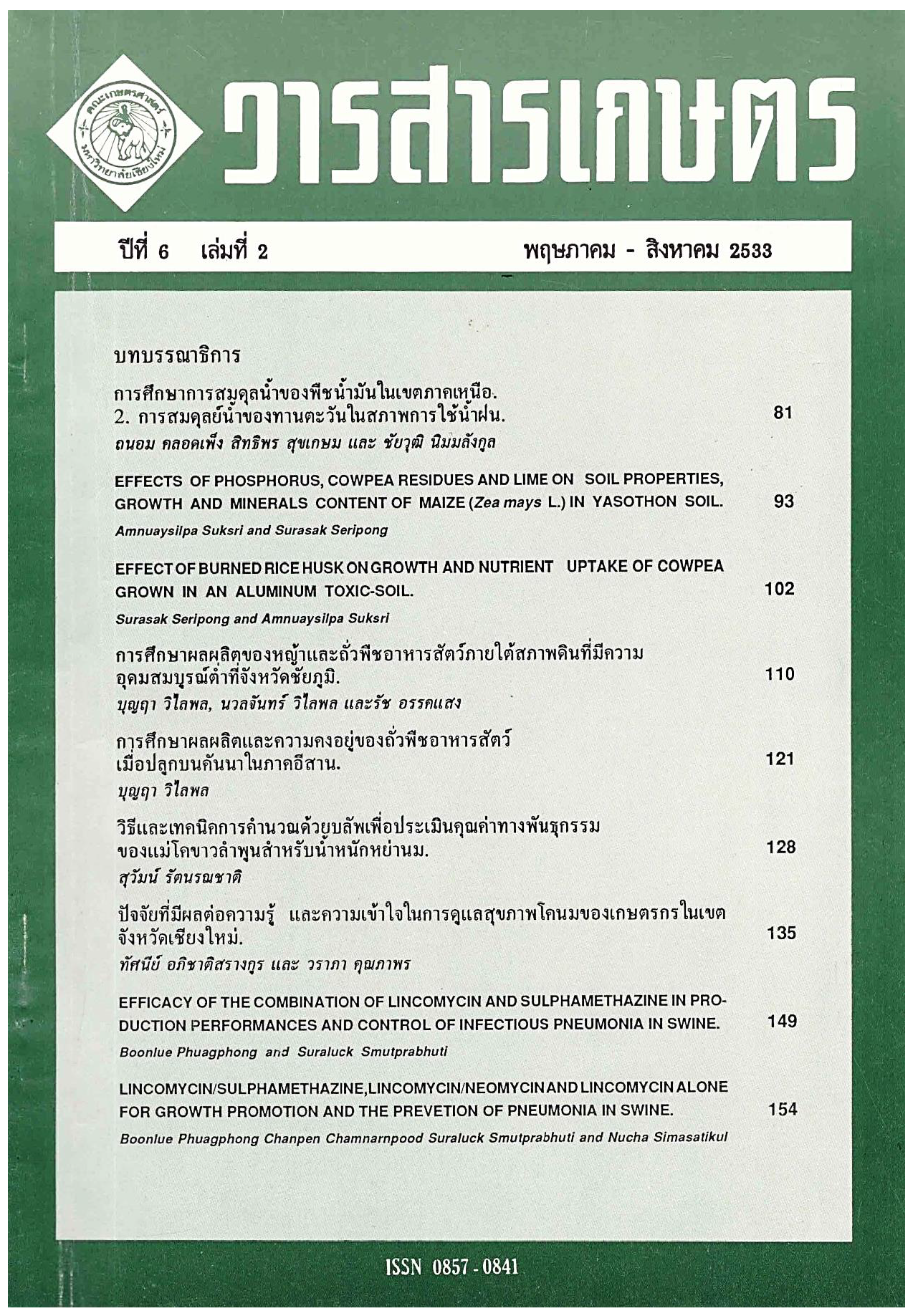EFFECT OF BURNED RICE HUSK ON GROWTH AND NUTRIENT UPTAKE OF COWPEA GROWN IN AN ALUMINUM TOXIC-SOIL
Main Article Content
บทคัดย่อ
The pot experiment was carried out under glasshouse at Khon Kaen University to study the effect of burned rice husk on dry matter yields and nutrient uptake of cowpea grown in aluminum- toxic soil. The treatment consisted of four levels of burned rice husk (0,12.50, 25.00, and 37.50 ton/ ha.) and aluminum (0,60,120 and 180 mg A1/kg of soil). The design of experiment was a factorial design arranged in randomized complete block with three replications. The results showed that dry matter yields of shoot and root of cowpea were affected by the percentages of soil aluminum saturation, the decrease in the amount of shoot plus root dry matter yields between the control treatment and the first level of aluminum treatment was as large as 47%. The percentages of soil aluminum saturation at approximately 25-30% reduced 50% dry matter yields of both shoot and root respectively. The three levels of burned rice husk increased dry matter yields over the control up to 33%, 51% and 62 respectively. Burned rice husk increased the uptake of N, P, K, Ca and Mg significantly but the reverse was with an increase in the amount of aluminum added to the soil.
Article Details
เอกสารอ้างอิง
Ahmad, F., and Tan, K.H. (1986). Effect of lime and organic matter on soybean seedlings grown in aluminum-toxic soil. Soil Sci. Soc. Am. J. 50: 656-661.
Barligar, V.C., Wright, R.J., Kinraide, T.B., Foy, C.D. and Elgin, Jr. J.H. (1987). Aluminum effects on growth, mineral uptake, and efficiency ratios in Red clover cultivars. Agron J. 79: 1038-1044. Chapman, H.D., and Pratt. P.F. (1961). Methods of analysis for soils, plants, and waters. Division of Agricultural Science. University of California, Berkeley, California.
Foy, C.D. (1984). Physiological effects of hydrogen, aluminum and manganese toxicities in acid soil. In F. Adams (ed.) Soil acidity and liming. Agronomy 12: 57-97.
Katawetin, R. (1982). Investigation on the effects of soil heterogeneity of Yasothon soil series on growth and production of sorghum. MSc. thesis, Kasetsart University, Bangkok, Thailand. 130 p.(in Thai with English abstract).
Lerner, B.R. (1983). Wood ash: Its chemical analysis, effect on soil reaction and development of snap bean (Phaseolus vulgaris L.). M.S. Thesis, The Ohio State Univ., Columbus.
Lerner, B.R., and Utizinger. J.D. (1986). Wood ash as soil liming material. Hort. Science. 21: 76-78. Panchaban, S., Katawetin, R., Sristaporn, P, Srijan, P., Sukwatnasombat, M., and Pracharnkarnjanas. (1989). The application of organic materials and chemical fertilizer in the improvement of soil properties and fertility status for increasing yield and income of sweet corn grower in the Northeast. Annual Report, 1989. Research Development Institute, Khon Kaen University. 69 p. (in Thai with English abstract.)
Rengel, Z., and Robinson D.L. (1989). Aluminum effects on growth and macronutrient uptake by annual ryegrass. Agron. J.81: 208-215.
Seripong, S. (1988). Responses of cowpea to applications of phosphorus and burned rice husk in an acid soil. Thai J.Agric. Sci. 21: 1-11.
Su, Nan-Rong. (1982). The use of industrial wastes for plant nutrient recycling in Taiwan, R.O.C. In The Recyling of Industrial Wastes For Agriculture. Food and Fertilizer Technology Center. Extension Bulletin No. 178.
Suwanarit, A. (1985). Soil salinity and acidity in soil, water, cropping systems research data bases relevant to rainfed agriculture in N.E. Thailand. Dept. of Soil Science, Kasetsart Univ., Bangkok, Thailand. p. 12-26.


